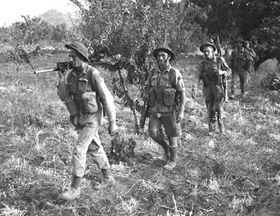Battle of Gasa Dzong
| Battle of Gasa Dzong | |||||||
|---|---|---|---|---|---|---|---|
| Part of the Nepali-Bhutania Campaign of the Second Europan War | |||||||
 Erebonian infantry from the Royal Elizabeth Rifles Regiment marching towards Gasa Dzong | |||||||
| |||||||
| Belligerents | |||||||
| Commanders and leaders | |||||||
| Strength | |||||||
|
3 infantry divisions 2 armoured divisions 3 armoured brigades 3 artillery regiment 3 REAF Squadrons |
4 mixed divisions 3 armoured divisions 2 SS Panzer Divisions 2 artillery regiments 1 IQAF squadron 1 Luftwaffe squadron | ||||||
| Casualties and losses | |||||||
| Moderate | Heavy | ||||||
The Battle of Gasa Dzong (12 April - 30 April 1943) was a battle that took place on the eponymous town. It called for Imperial forces to deny the town and attempt to damage or inflict heavy casualties on Marshal Archibald Sugiyama's northern flank. Here, Erebonian, Rubrumian, and Taoyuanese troops were stationed in Sugiyama's plan to conduct an offensive to the Himalaeyan Mountains. Imperial planners hoped that by attempting to knock the ERUAC forces out of the campaign, Sugiyama would lose his offensive arm in the campaign. On the other hand, Regnitz eyed for the control of the town of Gasa Dzong in order to establish a foothold in the north and prevent an Imperial control of the surrounding region.
The inconclusive stalemate at the Battle of Punakha offered Marshal Mạc Hiếu Quang enough time to regroup. But RAF raids on Imperial supplies bought by the previous battle caused delays bought by the delivery of supplies from Indiae would prove to be a big setback. While the Imperials were reorganising, Marshal Quang ordered General Phó Minh Duyên and elements of the SS Panzer Divisions to head to Gasa Dzong with select manpower that were still capable of fighting, hoping to deny the town to Sugiyama. On the other hand, Regnitz's forces were still capable of fighting at full strength and thus, made their way through the mountainous roads that Duyên's forces arrived too late to control the town, as the Allies held control of the town, much to the frustration of several Imperial commanders.
This still pitted them with the opportunity to encircle Regnitz' forces around the region in an attempt to destroy Sugiyama's northern flank. However, elements from the newly reinforced Utarapunjab and Taoyuanese forces soon reinforced Regnitz that enabled him to pull out his troops from the town to prepare for a thrust in the mountainous regions. Balambian Marshal A.C.G. Lindholm dispatched Balambian Jaegers to aid his push. In addition, the Utarapunjabs under Maharaja Singh provided Regnitz with much advantage on key areas which the Imperials could position themselves in. The locals also fiercely aided the Allied war effort by serving as local guides. The battle did not see much armoured confrontations but rather depended on infantry formations and mountain warfare.
The Imperials were keen on luring and disabling Regnitz ability to wage war by attempting to isolate and destroy his formation in the North of the mountains just near the border with the Himalaeyan Mountains. Quenminese Marshal Trương Ngọc Thái Bình called for several mountain divisions, aided by the SS Allgemeine with an experience in conducting mountain warfare. Despite all the promising Imperial efforts to halt Regnitz, Erebonian and Rubrumian infantry, aided by Balambian and Local troops overcame Imperial resistance in the mountains. Marshal Binh ordered one final attempt by attacking the Taoyuanese forces in the town. Although there were progress, Regnitz made a thrust towards south of the town, attempting to conduct an encirclement of Imperial forces. In this action alone, Regnitz was successful in isolating elements of the SS Allgemeine, along with several units of the Quenminese Mountain Regiments. By the end of April, Regnitz had finally removed the Imperial threat to Gasa Dzong that enabled Sugiyama to launch the Himalaeyan Offensive